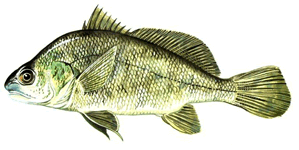Back to Previous Page
FRESHWATER DRUM

At-a-Glance
- Scientific Name: Aplodinotus grunniens
- Found in Illinois: Statewide
- State Average:
- State Record: Hook & Line: 38 lbs/4 oz (2018); Bowfishing: 20 lbs/4 oz (2023)
- Best Lures: small jigs, deep-diving crankbaits, spoons, minnow, night crawlers, crayfish and worms
Despite their reputation as a non-game fish, Freshwater Drum (Or "Sheepshead" as they are often called) are actually noted fighters when hooked and are known to be rather tasty when eaten. Fishing tackle should target the bottoms of lakes and rivers where the fish actively feed. A variety of jigs, deep-diving crankbaits, and spoons can be used to induce strikes. Live baits, such as crayfish or worms, can be used as well.
Habitat: The Freshwater Drum inhabits a variety of habitat types throughout much of North America. They can be found in warm, slow-moving rivers and lakes, generally preferring deeper water with an absence of thick plant cover. An adaptable species, Drum can be found in water ranging from clear to highly turbid.
Feeding and Habits: Freshwater Drum are primarily bottom feeders. Preferred prey changes as the fish grow, with the diet at times including insect larvae, crayfish, small fish, and mollusks.
Reproduction: Drum spawning takes place in the late spring/early summer, triggered by water temperature (typically spawning begins when the temperature reaches approximately 65 degrees Fahrenheit). Spawning takes place in the open water in areas not associated with plant or rocky cover. Males and females release sperm and eggs, respectively, into the water column where the eggs are fertilized at random. The fertilized eggs float freely for a few days before hatching into larvae. Mature male Drum are noted for the unique grunting sound they produce during the spawning season, though the exact purpose of the sound is still undetermined.



